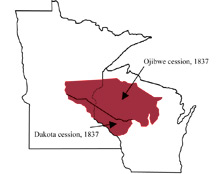1837 Land Cession Treaties with the Ojibwe & Dakota
Chippewa signed July 29, 1837 at present-day Mendota, MN
Sioux signed September 29, 1837 in Washington, D. C.
The first major land cessions by Dakota and Ojibwe people in what is now Minnesota coincided with the collapse of the fur trade. New owners of the American Fur Company – Ramsay Crooks, Henry Sibley and Hercules Dousman, with the Chouteau family of St. Louis – and other traders changed their business strategy from trading for furs to making treaties. They used powerful connections in the U.S. political system to ensure that when Dakota and Ojibwe people received compensation for ceded land, much of the cash would be used to pay fur trade debts.
The Dakota in their 1837 treaty received $16,000 in cash and goods up front, and promises of up to $40,000 per year for years to come. Their “relatives and friends” received $110,000, and fur traders received $90,000 in debt payments.
The Ojibwe received $24,000 in cash, goods and services, retaining rights to use the land for hunting, fishing and other purposes. Their mixed-blood relatives (including men who signed treaties on behalf of the U.S.) received $100,000; and fur traders received $70,000. Traders William Aitkin, Lyman Warren, and Hercules Dousman are mentioned by name as intended recipients of debt payments.
The fur trade was not the only business interest at work in these treaties. The Ojibwe treaty, called the "White Pine Treaty," transferred millions of acres of timber to the U.S.:
Officials in the administration of President Martin Van Buren sought the land cession not to accommodate white settlers – whites were not demanding Chippewa land – but to enable lumbering on a large scale.—Ronald N. Satz, Chippewa Treaty Rights
The cession of pine forests led to abuses of Ojibwe timber rights for a century, as treaty signers Dousman, Warren, and Sibley– as well as many other powerful political figures – suddenly widened their business interests from the fur trade to timber. Ojibwe negotiators made it clear, however, that they were retaining rights to deciduous trees in the region (among other rights), going so far as to lay an oak leaf in front of U.S. negotiator Henry Dodge to clarify their point. In fact, extensive evidence indicates that the Ojibwe believed they were merely leasing use of the pine forests, and many refused to leave the ceded territory, preferring to stay and exercise the rights to land use that they retained in the treaty. An important US Supreme Court ruling in 1999 upheld those rights. (See Treaty of 1855.)
Another factor in the Ojibwe treaty was the reported presence of copper deposits in the ceded territory. Henry Dodge, the US treaty commissioner and later governor of Wisconsin, had made a fortune in lead mining and particularly noted the presence of mineral deposits in preparation for the treaty.











